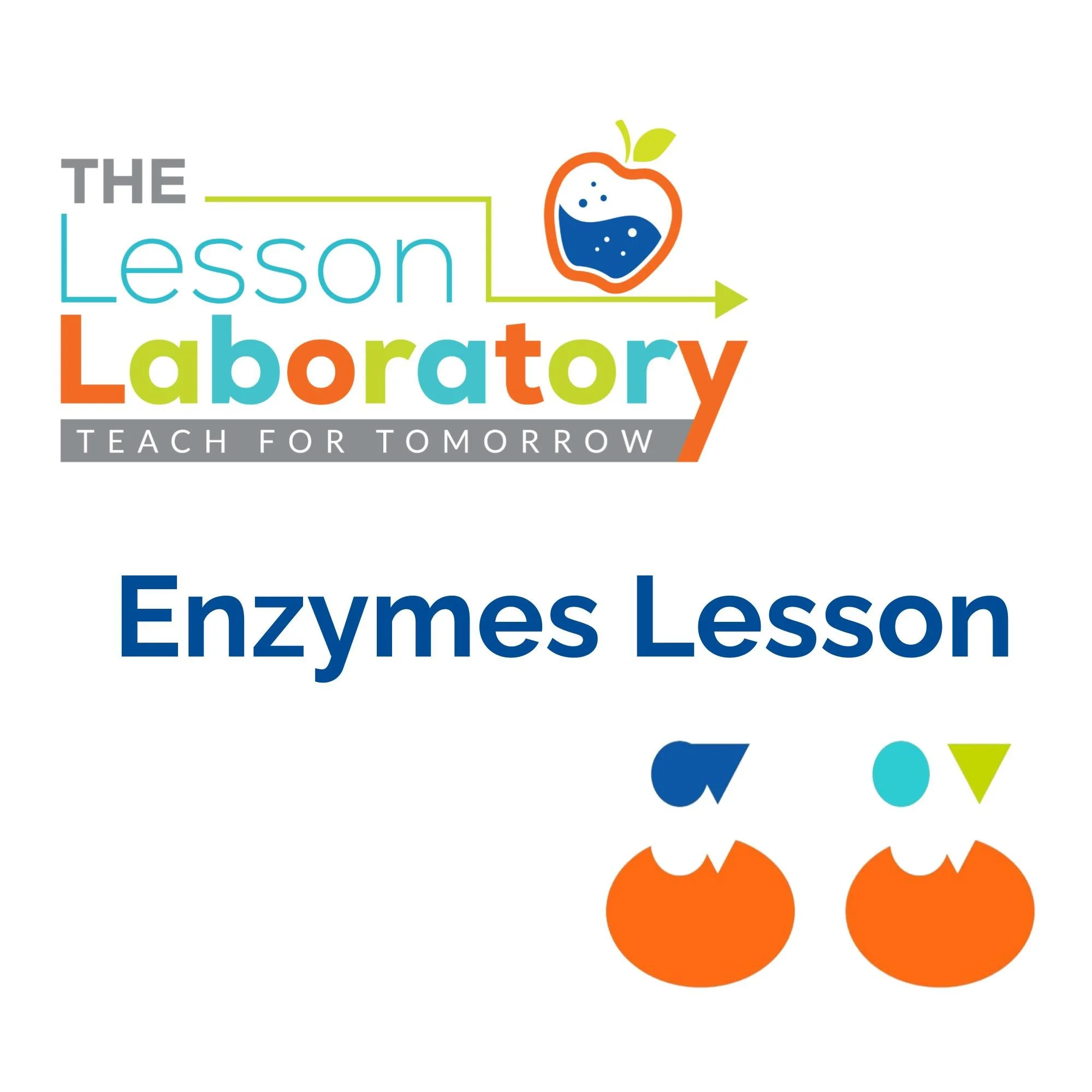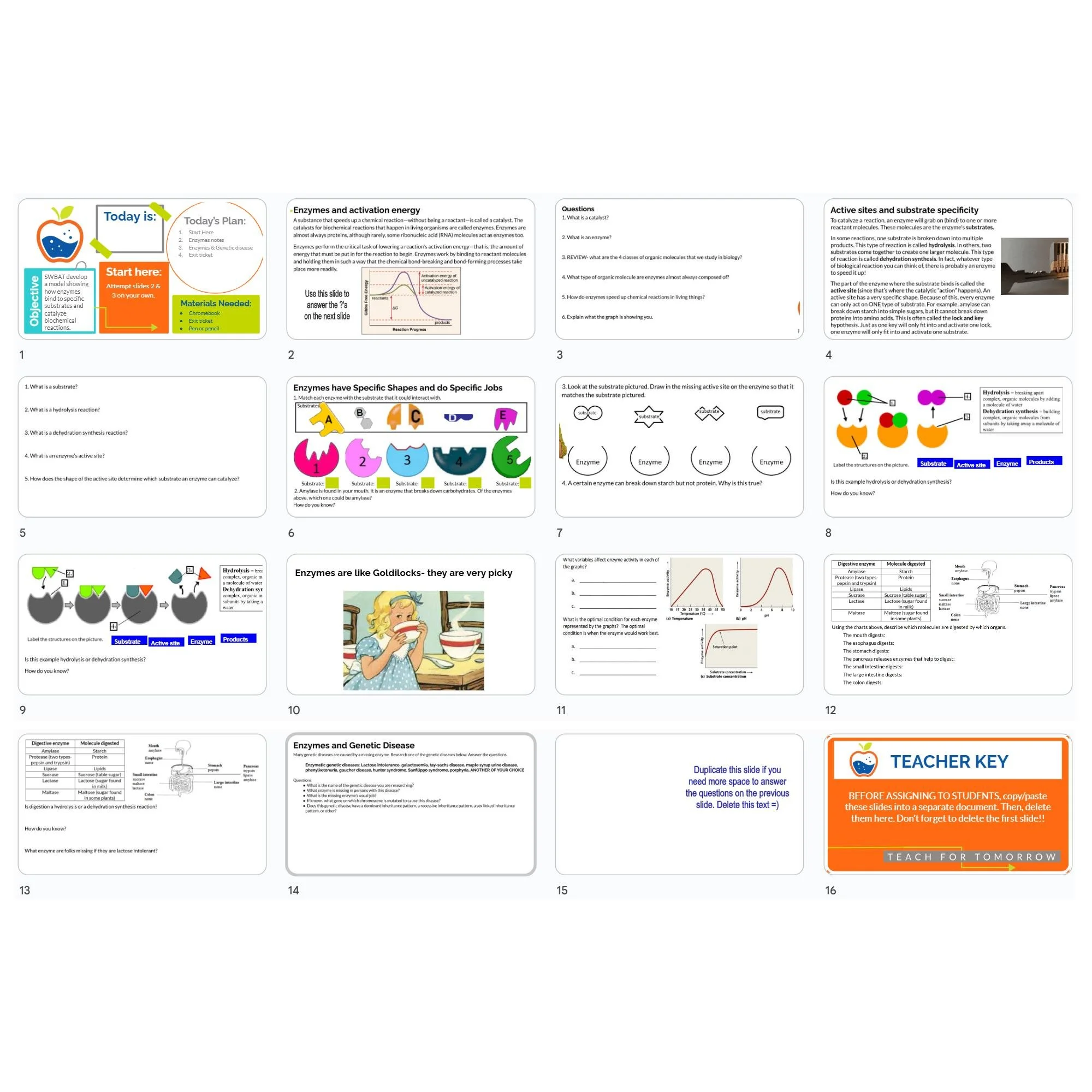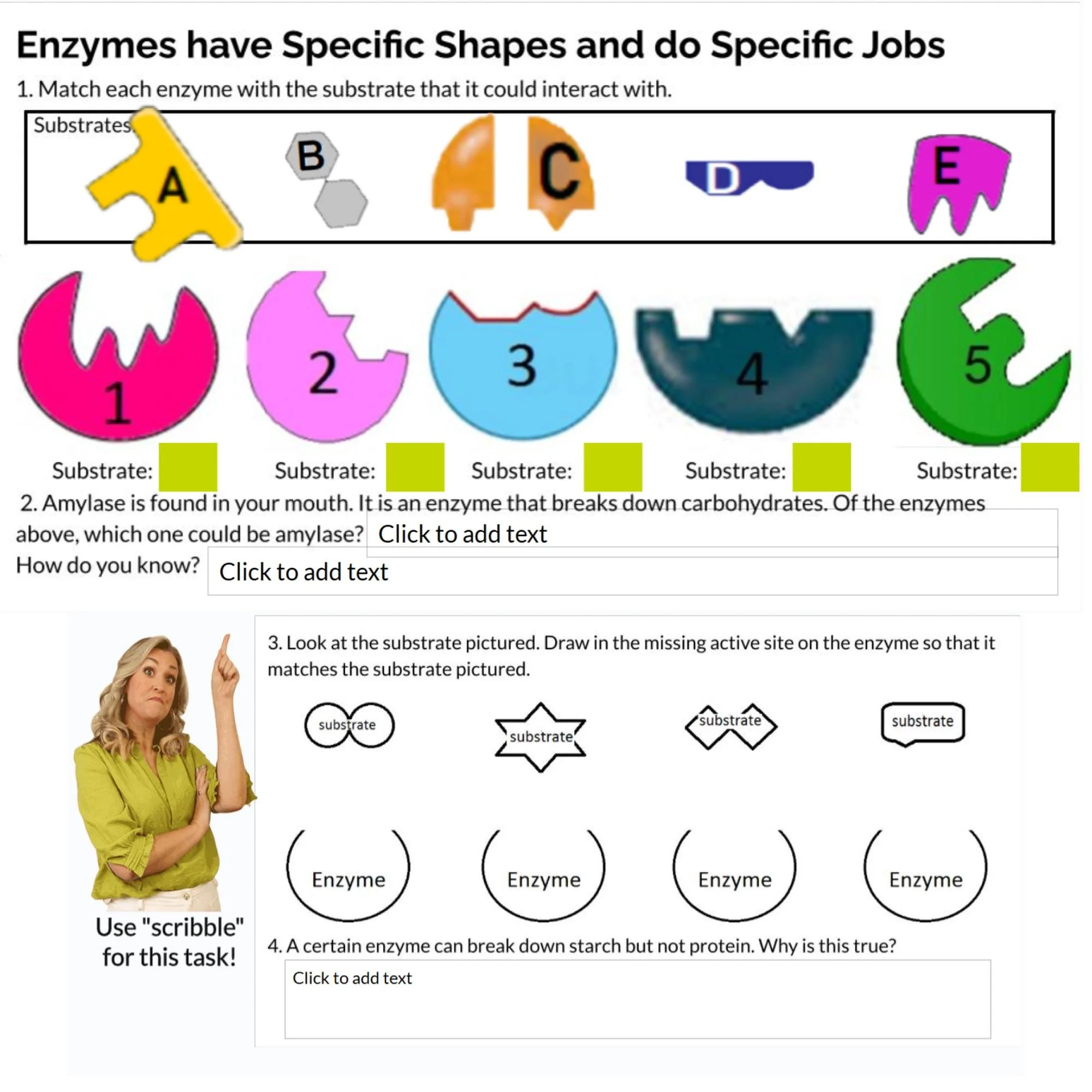



Enzymes Lesson | Active Site, Substrates & Biochemical Reactions (Modeling & Analysis)
Interactive Google Slides lesson introducing enzyme structure, active sites, substrate specificity, and reaction modeling.
This finely crafted Google Slides assignment immerses students in the fascinating world of enzymes. Designed to empower learners with a deep understanding of activation energy, active sites, and substrate specificity, it's a must-have addition to any biology curriculum.
The lesson unfolds with two concise readings, followed by comprehension questions that solidify key concepts. Students then step into an interactive experience, showcasing their grasp of enzyme specificity. Through drag-and-drop interactions, they match substrates to their corresponding enzymes and illustrate the active site within an enzyme for a pictured substrate.
The exploration continues with engaging activities, including labeling images with relevant vocabulary and analyzing graphs to discern the environmental factors influencing enzyme speed.
To anchor their knowledge in real-world contexts, students embark on a journey through the digestive system. They discern which nutrient molecules are digested in each organ, bridging the gap between theoretical learning and practical application.
As a culminating exercise, students delve into genetic diseases arising from missing or malformed enzymes. Through research and description, they gain a profound understanding of the real-world impact of enzyme deficiencies.
This assignment is a game-changer for educators seeking to provide a comprehensive and engaging enzyme learning experience. It's a perfect blend of theory, application, and real-world relevance.
Elevate your biology curriculum with the Enzyme Exploration Google Slides Assignment. Order now and equip your students with the knowledge and critical thinking skills needed to excel in the study of enzymes.
Grade Recommendation
Middle School: 7–8 (especially during biochemistry or cell processes units)
High School: 9–10 (Living Environment / Biology / NGSS LS1 content)
This lesson fits both levels because:
It covers foundational enzyme structure & function.
It includes reaction modeling and active site diagrams (HS-appropriate).
Examples and questions are accessible to grades 7–8.
Cross-Curricular Connections & Extensions
Cross-Curricular Connections
ELA: Students interpret diagrams, analyze vocabulary (substrate, catalyst, active site), and explain reasoning in writing.
Health Science: Introduces topics such as lactose intolerance and enzyme-related genetic diseases.
Chemistry: Reinforces activation energy, macromolecules, dehydration synthesis vs. hydrolysis.
Possible Extensions
Modeling enzyme denaturation with temperature or pH simulations (PhET).
Students design a mini-lab predicting “What will happen to enzyme activity if…?”
Research extension: enzymes in industry (cheese-making, detergents, biofuels).
Daily slide + literacy - based exit ticket included with purchase
Join the Lesson Laboratory and Teach for Tomorrow!
NGSS (Next Generation Science Standards)
MS-LS1-7 — Develop a model to describe how food is rearranged through chemical reactions forming new molecules that support growth and/or release energy.
(Students model enzyme-mediated hydrolysis and synthesis reactions.)MS-LS1-2 — Develop and use a model to describe the function of a cell as a whole and the ways parts of cells contribute to the function.
(Enzymes are linked to cellular chemical processes.)
HS-LS1-6 — Construct and revise an explanation based on evidence for how carbon, hydrogen, and oxygen from sugar molecules may combine with other elements to form amino acids and other large carbon-based molecules.
(Students explore dehydration synthesis and hydrolysis, connecting enzymes to macromolecule formation.)
HS-LS1-7 — Use a model to illustrate that cellular respiration is a chemical process in which bonds are broken and formed to transfer energy.
(Lesson reinforces enzyme action as part of energy transformation and metabolism.)Science & Engineering Practices: Developing and using models; Constructing explanations and designing solutions; Analyzing and interpreting data; Engaging in argument from evidence; Using mathematics and computational thinking
Crosscutting Concepts: Structure and function; Cause and effect; Energy and matter: flows, cycles, and conservation; Stability and change; Systems and system models
Common Core State Standards (ELA – Literacy in Science & Technical Subjects)
CCSS.ELA-LITERACY.RST.6-12.3 — Follow precisely a multistep procedure when carrying out experiments or analyzing data.
(Students follow instructions for modeling enzyme action or analyzing graphs.)CCSS.ELA-LITERACY.RST.6-12.7 — Integrate quantitative or technical information expressed in words and visual form.
(Students interpret enzyme graphs and reaction diagrams.)CCSS.ELA-LITERACY.WHST.6-12.2 — Write explanatory texts to convey scientific information.
(Students explain enzyme mechanisms and their importance to life processes.)
Interactive Google Slides lesson introducing enzyme structure, active sites, substrate specificity, and reaction modeling.
This finely crafted Google Slides assignment immerses students in the fascinating world of enzymes. Designed to empower learners with a deep understanding of activation energy, active sites, and substrate specificity, it's a must-have addition to any biology curriculum.
The lesson unfolds with two concise readings, followed by comprehension questions that solidify key concepts. Students then step into an interactive experience, showcasing their grasp of enzyme specificity. Through drag-and-drop interactions, they match substrates to their corresponding enzymes and illustrate the active site within an enzyme for a pictured substrate.
The exploration continues with engaging activities, including labeling images with relevant vocabulary and analyzing graphs to discern the environmental factors influencing enzyme speed.
To anchor their knowledge in real-world contexts, students embark on a journey through the digestive system. They discern which nutrient molecules are digested in each organ, bridging the gap between theoretical learning and practical application.
As a culminating exercise, students delve into genetic diseases arising from missing or malformed enzymes. Through research and description, they gain a profound understanding of the real-world impact of enzyme deficiencies.
This assignment is a game-changer for educators seeking to provide a comprehensive and engaging enzyme learning experience. It's a perfect blend of theory, application, and real-world relevance.
Elevate your biology curriculum with the Enzyme Exploration Google Slides Assignment. Order now and equip your students with the knowledge and critical thinking skills needed to excel in the study of enzymes.
Grade Recommendation
Middle School: 7–8 (especially during biochemistry or cell processes units)
High School: 9–10 (Living Environment / Biology / NGSS LS1 content)
This lesson fits both levels because:
It covers foundational enzyme structure & function.
It includes reaction modeling and active site diagrams (HS-appropriate).
Examples and questions are accessible to grades 7–8.
Cross-Curricular Connections & Extensions
Cross-Curricular Connections
ELA: Students interpret diagrams, analyze vocabulary (substrate, catalyst, active site), and explain reasoning in writing.
Health Science: Introduces topics such as lactose intolerance and enzyme-related genetic diseases.
Chemistry: Reinforces activation energy, macromolecules, dehydration synthesis vs. hydrolysis.
Possible Extensions
Modeling enzyme denaturation with temperature or pH simulations (PhET).
Students design a mini-lab predicting “What will happen to enzyme activity if…?”
Research extension: enzymes in industry (cheese-making, detergents, biofuels).
Daily slide + literacy - based exit ticket included with purchase
Join the Lesson Laboratory and Teach for Tomorrow!
NGSS (Next Generation Science Standards)
MS-LS1-7 — Develop a model to describe how food is rearranged through chemical reactions forming new molecules that support growth and/or release energy.
(Students model enzyme-mediated hydrolysis and synthesis reactions.)MS-LS1-2 — Develop and use a model to describe the function of a cell as a whole and the ways parts of cells contribute to the function.
(Enzymes are linked to cellular chemical processes.)
HS-LS1-6 — Construct and revise an explanation based on evidence for how carbon, hydrogen, and oxygen from sugar molecules may combine with other elements to form amino acids and other large carbon-based molecules.
(Students explore dehydration synthesis and hydrolysis, connecting enzymes to macromolecule formation.)
HS-LS1-7 — Use a model to illustrate that cellular respiration is a chemical process in which bonds are broken and formed to transfer energy.
(Lesson reinforces enzyme action as part of energy transformation and metabolism.)Science & Engineering Practices: Developing and using models; Constructing explanations and designing solutions; Analyzing and interpreting data; Engaging in argument from evidence; Using mathematics and computational thinking
Crosscutting Concepts: Structure and function; Cause and effect; Energy and matter: flows, cycles, and conservation; Stability and change; Systems and system models
Common Core State Standards (ELA – Literacy in Science & Technical Subjects)
CCSS.ELA-LITERACY.RST.6-12.3 — Follow precisely a multistep procedure when carrying out experiments or analyzing data.
(Students follow instructions for modeling enzyme action or analyzing graphs.)CCSS.ELA-LITERACY.RST.6-12.7 — Integrate quantitative or technical information expressed in words and visual form.
(Students interpret enzyme graphs and reaction diagrams.)CCSS.ELA-LITERACY.WHST.6-12.2 — Write explanatory texts to convey scientific information.
(Students explain enzyme mechanisms and their importance to life processes.)